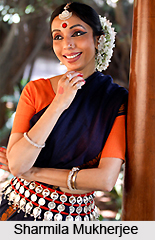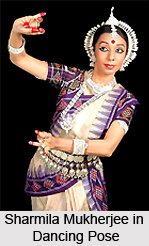 In the year 1982, Sharmila Mukherjee made her debut with the role of "Prakriti" in Rabindranath Tagore`s dance ballet-"Chandalika". Her performance received well appreciation from the audiences. The graceful beauty she has presented through her performance was outstanding. The traditional art form Odissi got a new language in the hands of Sharmila Mukherjee.
In the year 1982, Sharmila Mukherjee made her debut with the role of "Prakriti" in Rabindranath Tagore`s dance ballet-"Chandalika". Her performance received well appreciation from the audiences. The graceful beauty she has presented through her performance was outstanding. The traditional art form Odissi got a new language in the hands of Sharmila Mukherjee.
Sharmila Mukherjee after experiencing the graceful and lyrical beauty of this art form wanted to excel in the field of Odissi. She underwent a rigorous training under the strict supervision of legendary late Padmabibhushan Guru Kelucharan Mohapatra in Cuttack, Bhubaneswar and Calcutta respectively. Guru Kelucharan Mohapatra was a phenomenon in this traditionally rich heritage of art form from Orissa. Afterwards, Sharmila Mukherjee took part in many productions, choreographed and composed by her guru Kelucharan Mohapatra. Sharmila Mukherjee has played one of the lead roles namely `Chandrabali` in Tagore`s dance drama "Bhanushinger Padabali". This dance drama was executed in the year 1987, at New Delhi` s Kamani Auditorium under the aegis of Sangeet Natak Akademi.
However Sharmila Mukherjee with her determination and grace managed to capture the engrossment of the audiences. For her performances she has received rave reviews from the dance critics and leading connoisseurs of dance. Today she has carved a niche for herself in the arena amongst the finest exponents of Odissi in India. As a recognition, Sharmila Mukherjee has been conferred many honors. The Sur Singar Samsad, (Bombay) conferred her the title of Singar Mani. In Doordarshan, she is a Grade A artist. The Indian Council for Cultural Relations has also empanelled her as an established artist.
Sharmila Mukherjee has executed her performances throughout India as well as abroad.
Some of her performances in India to mention are: Kal Ke Kalakar Sangeet Sammelan (Bombay) in the year 1988; Dover lane Music Conference (Calcutta) in the year1989; Jhankar Music Conference (Calcutta) in the year1990; Youth Festival-Sangeet Natak Akademi (Trivandrum) in the year1993; Salt Lake Music Conference (Calcutta) in the year 1996;
 Vrindavan Festival (Uttar Pradesh) in the year 1998; Uday Shankar Dance Festival (Calcutta) for the year of 1999 and 2002; Deccan Festival (Hyderabad) in the year 2002; India International Centre (New Dlhi) in the year 2003; IRCEN (New Delhi) in the year 2005; Pallovutsav ( Mysore) in the year2005; Kinkini Festival (Bangalore) in the year 2006; Damaru Mahotsav(Bangalore) in the year 2006 and Brahmotsav (Iskcon Temple-Bangalore) in the year 2006.
Vrindavan Festival (Uttar Pradesh) in the year 1998; Uday Shankar Dance Festival (Calcutta) for the year of 1999 and 2002; Deccan Festival (Hyderabad) in the year 2002; India International Centre (New Dlhi) in the year 2003; IRCEN (New Delhi) in the year 2005; Pallovutsav ( Mysore) in the year2005; Kinkini Festival (Bangalore) in the year 2006; Damaru Mahotsav(Bangalore) in the year 2006 and Brahmotsav (Iskcon Temple-Bangalore) in the year 2006.
Sharmila Mukherjee has performed at Italy in the year 1997; U.S.A. (on a scholarship to the University of Michigan- Ann Arbor) in the year 2000; Fiji, Malaysia, Australia and New Zealand (ICCR tour) in the year 2003; Turkey (ICCR tour as part of a trio representing Odissi with Bharatnatyam and Kathak) in the year 2004 and at Dubai (Sponsored by the Indian Consulate) in the year 2006. Other than exhibiting performances she has also given many lecture demonstration on this traditional art form of Dance, Odissi. She has exhibited lecture demonstration at various consulates in Calcutta, University of Michigan (U.S.A.), Auckland University (New Zealand), and Bangalore University.
Sharmila Mukherjee has also bagged the opportunity of performing in front of the His Royal Highness, the Duke of Kent during his visit to India. This programme was organised by the British Deputy High Commission at Calcutta in the year 1994. Sharmila has also served as the faculty member of the Calcutta School of Music from the year 1991 to 2004. She has been teaching Odissi dance for many years. She was also ornamented the post of Secretary of the Indian Music Section of Calcutta School of Music. Her responsibility was there to look after the administrative side of this institution. Since the year 2004, she is residing at Bangalore and teaches Odissi at Sanjali-an institute of dance established by her.
Sharmila Mukherjee apart from being a professional dancer who runs a performing arts school, is also working for charity. For more than a decade, she is working with the hearing impaired children. Through dance she tries to make better the conditions of those children. At the Sheila Kothwala Institute for the Deaf, Sharmila Mukherjee is teaching Dance and Movements. These children have staged many performances under her guidance and choreography. "The Good Earth", "Vande Mataram" an extract from "Chandalika" and "Ramayan"- are all full-length dance drama to mention a few. These dance dramas was a prodigious success using mime and dance. Sharmila Mukherjee has also conducted and participated at workshops on Dance Movement Therapy. Her own institution, Sanjali also conducted a workshop on Dance Therapy with association of Tripura Kashyap at the Calcutta School of Music.



















